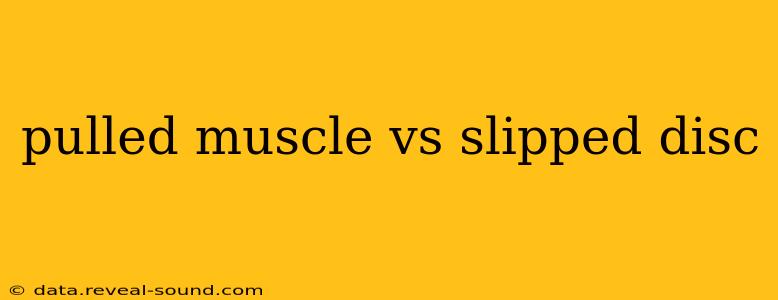Experiencing back pain can be debilitating, leaving you wondering about the underlying cause. Two common culprits are pulled muscles and slipped discs. While both can cause significant discomfort, they are distinct conditions with different causes, symptoms, and treatments. This article will delve into the key differences between a pulled muscle (muscle strain) and a slipped disc (herniated disc), helping you better understand your pain and seek appropriate medical attention.
What is a Pulled Muscle (Muscle Strain)?
A pulled muscle, more accurately termed a muscle strain, occurs when a muscle is overstretched or torn. This often happens during sudden movements, strenuous activity, or repetitive motions. The severity of a strain can range from mild discomfort to severe pain, depending on the extent of the muscle damage. Common locations for muscle strains include the lower back (lumbar region), hamstring, and calf muscles.
Symptoms of a Pulled Muscle:
- Pain: Localized pain in the affected muscle, often worsening with movement.
- Muscle spasms: Involuntary contractions of the muscle.
- Swelling: Mild to moderate swelling may occur around the injured muscle.
- Tenderness to the touch: The affected area may be painful when touched.
- Limited range of motion: Difficulty moving the affected muscle or joint.
What is a Slipped Disc (Herniated Disc)?
A slipped disc, more accurately called a herniated disc, involves the displacement of the soft, gel-like center of an intervertebral disc. These discs act as cushions between the vertebrae in your spine. When the outer layer of a disc tears, the inner material can bulge or rupture, potentially pressing on nearby nerves. This compression can cause pain, numbness, and weakness in the back, legs, or arms, depending on the location of the herniation.
Symptoms of a Slipped Disc:
- Pain: Pain that radiates down the leg (sciatica) is a common symptom of a herniated disc in the lower back. Arm pain can occur with herniated discs in the neck.
- Numbness or tingling: These sensations may be felt in the leg or arm, depending on the location of the herniated disc.
- Weakness: Muscle weakness in the affected limb may also occur.
- Sciatica: Sharp, shooting pain that travels down the buttock and leg is a hallmark of a lumbar herniated disc.
Pulled Muscle vs. Slipped Disc: Key Differences
| Feature | Pulled Muscle (Muscle Strain) | Slipped Disc (Herniated Disc) |
|---|---|---|
| Cause | Overstretching or tearing of a muscle | Displacement of the intervertebral disc's inner core |
| Location | Localized to the affected muscle | Can radiate pain down the limb(s) |
| Pain | Localized pain, worsening with movement | Can radiate, possibly causing sciatica or similar pain |
| Numbness/Tingling | Usually absent | Often present |
| Weakness | May be present, but usually mild | Can be significant |
| Diagnosis | Physical exam, often no imaging needed | Physical exam, often requires MRI or CT scan |
How are Pulled Muscles and Slipped Discs Diagnosed?
Diagnosing a pulled muscle usually involves a physical examination. Your doctor will assess your range of motion, palpate the affected area, and review your medical history. Imaging tests like X-rays are generally not needed for muscle strains.
A slipped disc, however, often requires imaging studies such as an MRI or CT scan to confirm the diagnosis and determine the severity of the herniation. These tests can visualize the disc and identify any nerve compression.
How are Pulled Muscles and Slipped Discs Treated?
Treatment for both conditions often involves conservative measures initially:
- Rest: Avoiding activities that aggravate the pain.
- Ice: Applying ice packs to reduce swelling and pain.
- Heat: Applying heat after the initial inflammation subsides can help relax muscles.
- Over-the-counter pain relievers: Such as ibuprofen or acetaminophen.
- Physical therapy: To improve muscle strength, flexibility, and posture.
For more severe cases of a slipped disc, more aggressive treatments may be considered, such as:
- Epidural steroid injections: To reduce inflammation and pain around the nerve.
- Surgery: In rare cases, surgery may be necessary to remove the herniated disc material or repair damaged vertebrae.
Can a pulled muscle lead to a slipped disc?
While a pulled muscle itself doesn't directly cause a slipped disc, severe muscle spasms or prolonged strain on the spine could potentially exacerbate existing disc degeneration, increasing the risk of herniation.
What's the difference in recovery time?
Recovery time varies depending on the severity of the injury and individual factors. Minor muscle strains may heal within a few weeks, while severe strains or herniated discs can take several months or longer to fully recover.
When should I see a doctor?
You should seek medical attention if:
- Your pain is severe or doesn't improve with home treatment.
- You experience numbness, tingling, or weakness in your limbs.
- You have difficulty controlling your bowels or bladder.
This information is for general knowledge and does not constitute medical advice. Always consult with a healthcare professional for diagnosis and treatment of any medical condition. They can accurately assess your specific situation and recommend the most appropriate course of action.
